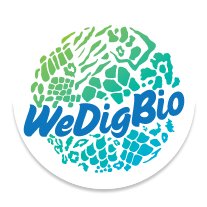This growing list of documents provides ideas for lesson plans that you may implement during the WeDigBio event. You may also find them useful for working with students and the online transcription centers outside of the event itself. Feel free to modify these to suit your needs and personalize them based on the chosen transcription center and project. Do you have a lesson plan or educational activity you'd like to share with the WeDigBio community? Please email it to us and we'll post it here.
Two videos that introduce herbaria (Video 1) and how they benefit from your efforts (Video 2), starring Austin Mast and Katelin Pearson. These videos are normally behind a paywall at CPALMS, but will be available for the week of WeDigBio in April and October.
- Video 1: Library of Scientific Plant Samples: Step Inside an Herbarium
- Video 2: Crowd-sourced Herbarium Data Transcription
Undergraduate Classroom Exercise. This exercise was created in collaboration with our colleagues at collectionseducation.org.
The WeDigBio Event as an opportunity for extra credit in your undergrad class. Thanks to Andrea Weeks for sharing.
The high school classroom exercise, "Using Notes from Nature", has three documents associated with it: teacher instructions, student instructions, and a student activity sheet. Thanks to Kari Harris, Jill Czerwonky, Travis Marsico, and the Southeast Regional Network of Expertise and Collections (SERNEC).
This high school lesson plan, Help Behind-the-Scenes at a Museum as a Citizen Scientist, focuses on Florida plants, but could easily be adapted to any region or taxa.
Many of the educational videos produced by ScienceLIVE involve collections, collections data, and biodiversity researchers and can serve as informative introductory or supplementary materials. For example, Prairie Fens and Poweshiek Skipperlings follows a group of researchers as they collect and use herbarium specimens to better understand an endangered butterfly species and its host plants.






